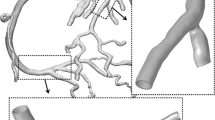Abstract
Coronary stent implantation has become an important method, of treating coronary heart disease. It has a pre-compression process when using the stent, which will be fixed in the balloon, and then be processing the expansion of operations. This research use the FE method, without considering the interaction of vessel stents and the circumstances under artery loading to simulate the three different materials (CoCr alloy, 316L stainless steel and Mg alloy), but it must has the same free pre-compression expansion process of the structure of the stent. By setting the mesh of the FE stent models, the boundary conditions, the loading, etc, and other key factors, The results demonstrate deformation mechanism, which can be used to calculate radical recoil rate and axial shortening rate. At last, the safety factors of stents are forecasted.
Access this chapter
Tax calculation will be finalised at checkout
Purchases are for personal use only
Preview
Unable to display preview. Download preview PDF.
Similar content being viewed by others
References
Ni, Z., Wang, Y., Chen, J.: Numerical simulation method of balloon-expandable coronary stents expansion mechanism. School of Mechanical Engineering 44(1), 102–108 (2008)
Qi, M., Si, C., Wang, W.: Stress change during the expanding process of magnesium alloy stents with different strut shapes and sizes. Journal of Clinical Rehabilitative Tissue Engineering Research 38, 7133–7135 (2010)
Wang, W., Liang, D.: The finite element analysis of the transitorily expanding process and design optimization of coronary stent system. Chinese Journal of Biomedical Engineering 24(3), 313–319 (2005)
Migliavacca, F., et al.: On the effects of different strategies in modeling balloon-expandable stenting by means of finite element method. Journal of Biomechanics 41, 1206–1212 (2008)
Author information
Authors and Affiliations
Corresponding author
Editor information
Editors and Affiliations
Rights and permissions
Copyright information
© 2012 Springer-Verlag GmbH Berlin Heidelberg
About this paper
Cite this paper
Feng, H., Jiang, X., Guo, F., Wang, X. (2012). Finite Element Analysis in Vitro Expansion of Coronary Stents. In: Jin, D., Lin, S. (eds) Advances in Future Computer and Control Systems. Advances in Intelligent and Soft Computing, vol 160. Springer, Berlin, Heidelberg. https://doi.org/10.1007/978-3-642-29390-0_92
Download citation
DOI: https://doi.org/10.1007/978-3-642-29390-0_92
Publisher Name: Springer, Berlin, Heidelberg
Print ISBN: 978-3-642-29389-4
Online ISBN: 978-3-642-29390-0
eBook Packages: EngineeringEngineering (R0)




